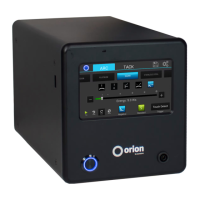23
OrionWelders.com
Using the following can help reduce oxide formation on the back of the workpiece:
1. Argon flood on both sides of the workpiece during the welding process. is is the best method but can use a lot of
gas and requires additional setup.
2. Solder flux: A thick layer of solder flux can help reduce oxide formation. Place the flux on the back side of the
workpiece. e flux should be as viscous and thick as possible. Some fluxes may work better than others.
After saying all of the above, it should be noted that titanium is very simple to weld. With proper gas shielding, the weld
looks bright and clean. Titanium to titanium welds are simple to perform and are strong. Titanium welded to other metals
can have a variety of results. For example (Ti) to Gold (Au) results in a clean looking but brittle weld. Copper to (Ti) has
similar results. Silver to (Ti) is relatively strong. When welding (Ti) to other materials remember to test the weld strength
with scrap pieces before welding the final workpiece.
One important consideration when welding (Nb) is it’s high boiling temperature (4742 deg C) relative to tungsten’s melting
temperature (3410 deg C). What this means: if the tungsten electrode is contaminated with (Nb) metal the (Nb) metal may
superheat and start to boil right on the electrode. is boiling of the (Nb) will in turn melt the tungsten electrode causing it
to lose its sharp shape.
YELLOW / WHITE GOLD AU
Yellow gold is a relatively simple material to weld. Typically, it will produce a strong and symmetric weld spot and resulting
welds are smooth and require little cleanup. is is true for even lower Karat golds; however, please note that weld
results will improve with higher gold content. Typically, the different metals added to gold are used to change its wear
characteristics and color. e more additional metal added (not gold) the lower the karat value. Lower karat golds that
contain copper and silver, etc. can produce a black coating around the weld’s surface. is can easily be steam cleaned,
wiped off with a clean rag, or taken off with a glass brush.
Please also note that sometimes during the welding process a small amount of the welded metal will evaporate. Different
metals will evaporate at different rates from the weld pool. e evaporated metal can deposit around the weld location in
a very thin layer that can look black. is type of deposit can typically be removed by steam cleaning, wiping with a clean
rag or with a glass brush.
Please also note that some gold alloys can contain small amounts of zinc (0.5-1.0%). is zinc addition is used as a
deoxidizer during casting, and can improve the fluidity of the molten metal. As discussed above, zinc can cause porosity
and will contribute to a black film that must be removed via glass brush or clean rag.
Yellow gold physical properties and composition (one possible):
58-75% gold, 12-27% silver, 9-15% copper and some zinc
WHITE GOLD:
White gold is also a relatively simple metal to work with. ere are two main types of white golds – palladium-white gold
and nickel-white gold.
Palladium – white gold composition (one possible):
58.5% gold, 10% palladium, 28.5% silver, 2.5% (copper, nickel, zinc)
Nickel – white gold composition 14k (one possible):
58.5% gold, 25.8 % copper, 15.3% nickel, 0.4% zinc
Gold color can be changed with the following alloying (show alloy chart by composition and color)
Note the zinc content of white gold. High zinc content can lead to weld defects like porosity, etc. as the zinc boils out of the
weld joint. Please see the previous discussion on overcoming porosity. In short, welding over the location with porosity

